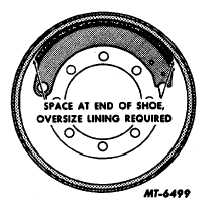|
| |
TRUCK SERVICE MANUAL
TM 5-4210-230-14&P-1
BRAKES-HYDRAULIC
To recondition a brake drum in a lathe (Fig. 7), the
drum must be mounted so that it is centered. Use proper size
cone to provide accurate centering. Turn drum, taking only
light cuts and remove just enough material to clean up drum.
Then grind the finished surface if grinder is available or use
emery cloth on a straight piece of wood and polish the drum
friction surface.
Fig. 7 Reconditioning Drum on Brake Drum Lathe
Brake drums should be cleaned thoroughly with a
steam cleaner or hot water. Do not use a solvent which
leaves an oily residue. If inspection shows the drums may be
used without remachining, rub friction surface with fine emery
cloth or sandpaper to remove any foreign deposits. If drum
has been reconditioned, clean friction surface with fine emery
cloth or sandpaper and wash. Next examine very carefully to
see that no metal chips remain in drum.
INSPECTION OF SHOES
Figure 8 Defects to be looked for on Brake Shoe
When brake linings or blocks are worn to within .8
mm (1/32") on light duty vehicles or 1.6 mm (1/16") on
medium and heavy duty trucks of rivets, the brake shoes must
be removed and relined. It is recommended that all the
brakes be relined at the same time since this will maintain
balanced braking on the vehicle. If complete replacement is
not desirable or necessary, be sure that all lining on one axle
(both sides) is replaced at the same time.
Examine shoes carefully and discard those which
have any defects as shown in Fig. 8.
REPLACING LINING ON SHOES
When removing worn lining from shoes, drill out old
rivets if possible to prevent distorting shoe table. After the old
linings are removed from the shoes, the shoes should be
cleaned and buffed to remove all dirt and grease. Grease is
one of the greatest deteriorating agents of lining.
Discard used lock washers after removing lining
bolts. Use new washers when installing new lining. Replace
bolts and nuts if signs of distortion or wear are present.
Do not handle new brake linings or relined shoes with
greasy hands or allow linings to come in contact with mineral
oil or grease.
Care should be used in selecting the correct
thickness of lining for each brake shoe and drum. Usually the
standard thickness will be used. If the drum has been turned
or become worn, increasing the diameter, oversize lining may
be required.
Fig 9 Lining Selected too thin
CTS-2779 Page 5
PRINTED IN UNITED STATES OF AMERICA
|



